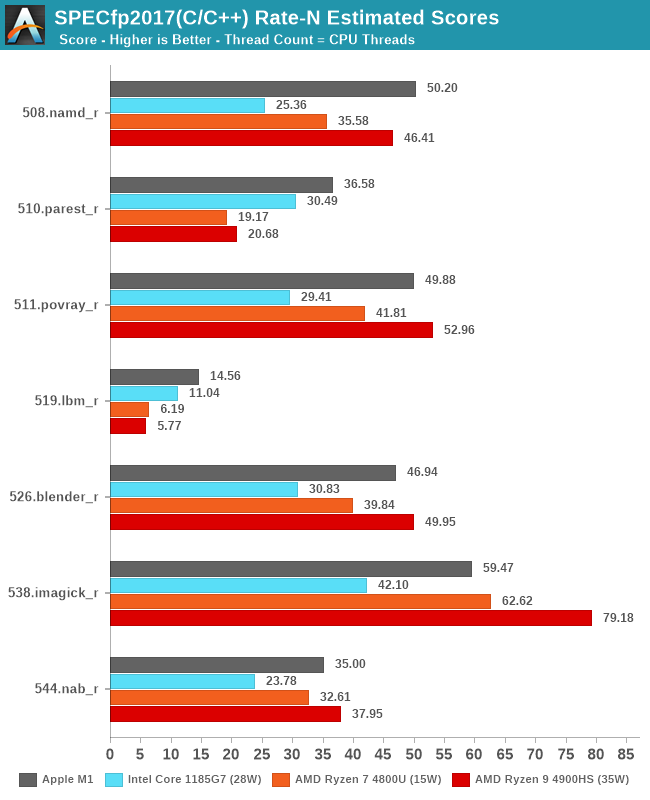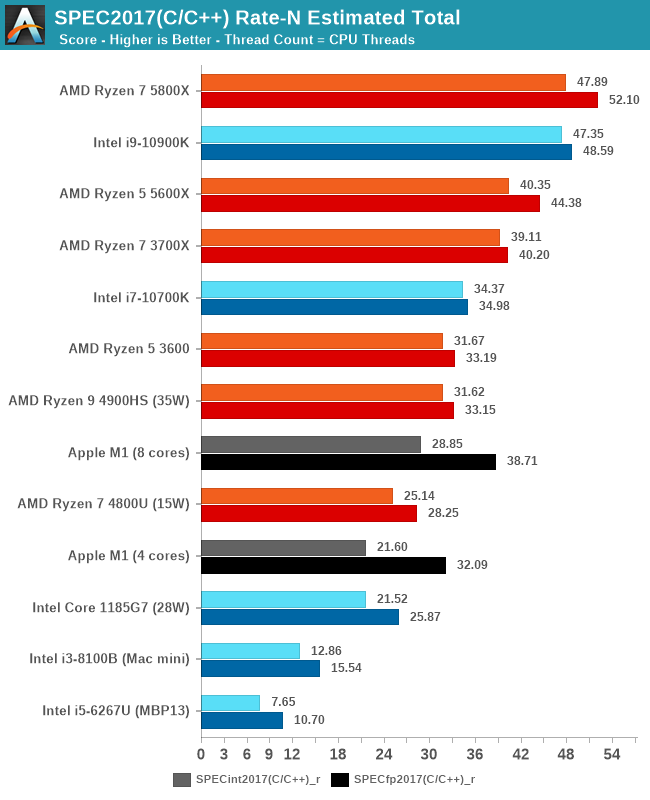The 2020 Mac Mini Unleashed: Putting Apple Silicon M1 To The Test
by Andrei Frumusanu on November 17, 2020 9:00 AM ESTSPEC2017 - Multi-Core Performance
While we knew that the Apple M1 would do extremely well in single-threaded performance, the design’s strengths are also in its power-efficiency which should directly translate to exceptionally good multi-threaded performance in power limited designs. We noted that although Apple doesn’t really publish any TDP figure, we estimate that the M1 here in the Mac mini behaves like a 20-24W TDP chip.
We’re including Intel’s newest Tiger Lake system with an i7-1185G7 at 28W, an AMD Ryzen 7 4800U at 15W, and a Ryzen 9 4900HS at 35W as comparison points. It’s to be noted that the actual power consumption of these devices should exceed that of their advertised TDPs, as it doesn’t account for DRAM or VRMs.

In SPECint2017 rate, the Apple M1 battles with AMD’s chipsets, with the results differing depending on the workload, sometimes winning, sometimes losing.

In the fp2017 rate results, we see similar results, with the Apple M1 battling it out with AMD’s higher-end laptop chip, able to beat the lower TDP part and clearly stay ahead of Intel’s design.

In the overall multi-core scores, the Apple M1 is extremely impressive. On integer workloads, it still seems that AMD’s more recent Renoir-based designs beat the M1 in performance, but only in the integer workloads and at a notably higher TDP and power consumption.
Apple’s lead against Intel’s Tiger Lake SoC at 28W here is indisputable, and shows the reason as to why Apple chose to abandon their long-term silicon partner of 15 years. The M1 not only beats the best Intel has to offer in this market-segment, but does so at less power.
I also included multi-threaded scores of the M1 when ignoring the 4 efficiency cores of the system. Here although it’s an “8-core” design, the heterogeneous nature of the CPUs means that performance is lop-sided towards the big cores. That doesn’t mean that the efficiency cores are absolutely weak: Using them still increases total throughput by 20-33%, depending on the workload, favouring compute-heavy tasks.
Overall, Apple doesn’t just deliver a viable silicon alternative to AMD and Intel, but actually something that’s well outperforms them both in absolute performance as well as power efficiency. Naturally, in higher power-level, higher-core count systems, the M1 can’t keep up to AMD and Intel designs, but that’s something Apple likely will want to address with subsequent designs in that category over the next 2 years.










682 Comments
View All Comments
Der Keyser - Tuesday, November 17, 2020 - link
This release is going to be an interesting change in the industryKevin G - Tuesday, November 17, 2020 - link
There is also the business side of it too which is gonna be full of Game of Thones-like drama with nVidia attempting to acquire ARM. Apple and nVidia notoriously don't get along. Apple's relationship with Imagination Technologies is also strained but they've seemingly made up so that Apple can gain access to some ray tracing acceleration designs. Apple still seems to be on good terms with AMD but moving away from them as a supplier on the Mac side right now due to the ARM transition in general.YesYesNo - Tuesday, November 17, 2020 - link
Thankfully chaos is a ladder.helios24 - Tuesday, November 17, 2020 - link
Apple has an Architecture License with ARM. Basically the broadest license that ARM sells. If you didn't know this, ARM was founded as a joint venture between Apple and Acorn. Apple's license is also perpetual. That is the reason why Apple isn't interested in acquiring ARM. Apple does not use ARM designs, they use certain principles present in the ARM architecture and the ISA. Apple then makes cpus that can run ARM instruction set, that is the reason why you see big difference between apple designed SoC vs Qualcomm or ARM design.Tams80 - Tuesday, November 17, 2020 - link
Apple's not interested in buying ARM mainly because it would never be allowed to happen (without Apple splitting up), so trying to do so would be a complete waste of time.dejuknow - Tuesday, November 17, 2020 - link
Nope. Apple would still have no reason to purchase ARM even if it were allowed to happen. helios24 is completely correct. Apple has no interest in licensing technology to third parties.nevernotmaybe - Friday, November 20, 2020 - link
Apple cares about nothing other than making money, if they could have a subsidiary printing money while they continue as normal they would do it instantly. The idea they wouldn't is laughable.skingers - Monday, November 23, 2020 - link
Not laughable at all. Apple have tonnes of free cash that they could use to buy something they don't really need that makes money, but they don't do it. Instead they buy back their own stock. The other commenters here are correct, Apple already have, in perpetuity, what they need for their chip designs and they are backing themselves to be best in the business at it.helpmeoutnow - Thursday, November 26, 2020 - link
but they were never the best in the business, so how come?alysdexia - Monday, December 28, 2020 - link
die, troll http://google.com/search?q=Apple+TCO